Das Canon EF 35 mm 1:2 IS USM hatte ich schon an anderer Stelle wegen seiner optischen Qualitäten gelobt. Am Crop-Sensor etwa ein Normalobjektiv, habe ich es sogar für Repros genutzt – und meine wahre Freude daran gefunden.
Dabei kann man mit diesem Objektiv wirklich nicht prahlen. Die Anfangsöffnung von 1:2 wird für ein „Normalobjektiv“ eher belächelt: Als „Leistungsmerkmal“ eines Normalobjektivs von vor 70 Jahren. Oder so. Die bemerkenswerte Schärfeleistung aber, und ebenso die sehr gute Korrektur von Abbildungsfehlern spricht eine andere Sprache. Da lohnt es sich wirklich, dieses Objektiv mit einem Vollformat-Äquivalent von 56 mm gerne in Betracht zu ziehen.
Mehr über dieses Objektiv könnte ihr hier lesen.
Canon EF 35 mm 1:2 IS USM bestechend gut für Reproduktionen:
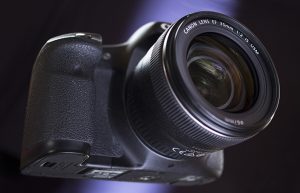
Die Lichtverhältnisse stellten kaum ein Problem dar. Mit zwei Yongnuo 560 III, bequem und in unterschiedlicher Anpassung über Funkauslöser angesteuert, indirekt gegen Weiß eingesetzt. So war die Lichtfrage überraschend schnell bewältigt. Bei beengten räumlichen Verhältnisse drohten die Repros dann schon eher an den Aufnahmedistanzen zu scheitern. Da war ich bei Großformaten von bis zu 100 x 120 cm froh, mit dem Canon EF 35 mm 1:2 IS USM ein hochwertiges „Normalobjektiv“ zu meiner Ausrüstung zählen zu können.
Die Canon 7D hat sich hier gemeinsam mit dem Canon EF 35 mm 1:2 IS USM wirklich prima geschlagen. Das Objektiv hat mich durchweg voll und ganz überzeugt mit einer Blende von meistens f/5.0. Die Linse besticht in stiller Bescheidenheit mit Schärfe und Kontrastreichtum – und benimmt sich überzeugend farbneutral, wo die Malerin ihre Werke nicht gern durch das technische Material in den Repros neu interpretiert gesehen hätte.
Ulrike Schieferstein: Malerin besticht durch authentischen Ausdruck
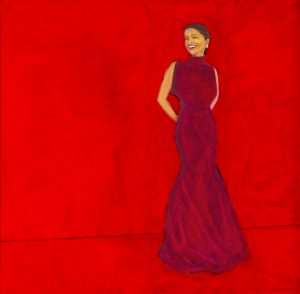 „Eleganz“, Ulrike Schieferstein
„Eleganz“, Ulrike Schieferstein
An einem Tage im Sommer 2016, mit beinahe dem kompletten Equipement im Rucksack, war ich aus Essen zurückgekommen. Da lief mir zufällig die Langenberger Malerin Ulrike Schieferstein gleichsam quer in den Weg. Aber ich hatte Zeit. Es kam mir überhaupt nicht quer. Und was sie an Kunst erschafft, muss man gesehen haben. Ulrike Schieferstein lässt Herzblut auf die Leinwand fließen. Und das mit einer zügigen und sicheren Pinselführung, ohne sich in Details zu verlieren. Man spürt, dass da erlebte Visionen von innen nach außen wachsen – und in Öl auf Leinwand den angemessenen Ausdruck beanspruchen.
 „Blütenkelch“, Ulrike Schieferstein
„Blütenkelch“, Ulrike Schieferstein
Dabei ist die Malerin Ulrike Schieferstein nicht nur mit ihren Menschenbildern ausdruckssicher. Auch mit ihren abstrakten Motiven versteht sie zu treffen und anzurühren. – Schaut mal auf ihre Website, um noch ein paar mehr Eindrücke mitzunehmen.

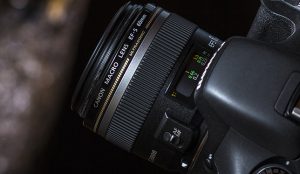
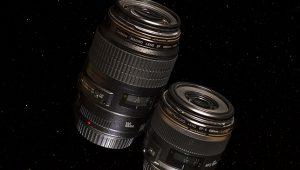
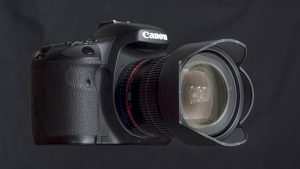

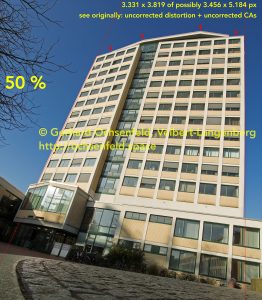



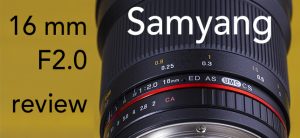
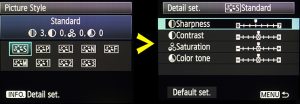 standard „picture style“
standard „picture style“ my standard definition
my standard definition